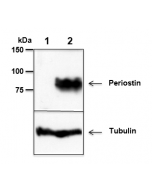Cookie Policy: This site uses cookies to improve your experience. You can find out more about our use of cookies in our Privacy Policy. By continuing to browse this site you agree to our use of cookies.
AdipoGen Life Sciences
Periostin (human) ELISA Kit

| Product Details | |
|---|---|
| Synonyms | Osteoblast-specific Factor 2; OSF-2; Postn |
| Product Type | Kit |
| Properties | |
| Application Set | Quantitative ELISA |
| Specificity | Detects natural and recombinant human periostin. Has been tested on human periostin isoforms 1 and 2 (should also detect human isoforms 3 and 4). |
| Crossreactivity | Human |
| Quantity | 1 x 96 wells |
| Sensitivity | 15pg/ml |
| Range | 78 to 5000pg/ml |
| Sample Type |
Cell Culture Supernatant Plasma Serum |
| Assay Type | Sandwich |
| Detection Type | Colorimetric |
| Shipping and Handling | |
| Shipping | BLUE ICE |
| Short Term Storage | +4°C |
| Long Term Storage | +4°C |
| Handling Advice |
After standard reconstitution, prepare aliquots and store at -20°C. Avoid freeze/thaw cycles. Plate and reagents should reach room temperature before use. |
| Use/Stability | 12 months after the day of manufacturing. See expiry date on ELISA Kit box. |
| Documents | |
| Manual |
 Download PDF Download PDF |
| MSDS |
 Download PDF Download PDF |
| Product Specification Sheet | |
| Datasheet |
 Download PDF Download PDF |
Periostin is a 90-kDa matricellular protein that consists of a typical signal sequence, followed by a cysteine-rich region, an EMI domain (protein-protein interactions), four tandem fasciclin-like domains that are responsible for integrin binding, and a C-terminal region. Periostin was originally isolated as an osteoblast-specific factor that functions as a cell adhesion molecule for pre-osteoblasts and in osteoblast recruitment, attachment and spreading. Periostin is also involved in many fundamental biological processes such as cell proliferation, cell invasion and angiogenesis. Periostin expression is increased by both transforming growth factor β1 (TGF-β1) and bone morphogenetic protein 2 (BMP-2). Changes in periostin expression are commonly detected in various cancers and pre-cancerous conditions, and periostin may be involved in regulating cancer cell activities that contribute to tumorigenesis, cancer progression and metastasis. Periostin up-regulation in cancers usually correlates with aggressiveness and/or poor survival. Periostin has shown to be involved in many aspects of allergic inflammation, such as eosinophil recruitment, airway remodeling, development of a Th2 phenotype and increased expression of inflammatory mediators. It is evaluated as a biomarker for bronchial asthma and airway inflammation.
- Elevated expression of periostin in human osteoarthritic cartilage and its potential role in matrix degradation via matrix metalloproteinase-13: M. Attur, et al.; FASEB J. 29, 4107 (2015)
- Plasma periostin associates significantly with non-vertebral but not vertebral fractures in postmenopausal women: Clinical evidence for the different effects of periostin depending on the skeletal site: B.-J. Kim, et al.; Bone 81, 435 (2015)
- Tumor cell-derived periostin regulates cytokines that maintain breast cancer stem cells: A.W. Lambert, et al.; Mol. Cancer Res. 14, 103 (2016)
- Serum IL-5 and IL-13 consistently serve as the best predictors for the blood eosinophilia phenotype in adult asthmatics: I. Agache, et al.; Allergy 71, 1192 (2016)
- Prospective assessment of serum periostin as a biomarker for diagnosis and monitoring of eosinophilic oesophagitis: E.S. Dellon, et al.; Aliment. Pharmacol. Ther. 44, 189 (2016)
- Serum periostin levels in early in pregnancy are significantly altered in women with miscarriage: A. Freis, et al.; Repr. Biol. Endocrinol. 15, 87 (2017)
- Plasma Periostin and Delayed Cerebral Ischemia After Aneurysmal Subarachnoid Hemorrhage: H. Kanamaru, et al.; Neurotherapeutics 16, 480 (2019)






